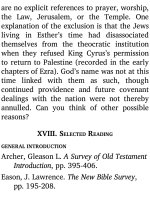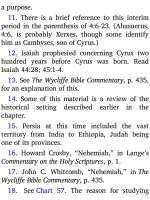Jensens survey of the old testament adam 537
Bạn đang xem bản rút gọn của tài liệu. Xem và tải ngay bản đầy đủ của tài liệu tại đây (117.52 KB, 4 trang )
a concordance for the appearances of these
three words: deacon, minister, servant.
2. Functions.
a . Overseers were superintendents of a
local church. They were also the teachers
and preachers of the congregation, having
the responsibility of feeding the ock (Acts
20:28; cf. 1 Pet. 5:2). Other duties included
guarding the congregation from spiritual
harm (Acts 20:29-31); being examples to the
members (1 Pet. 5:3); and visiting those in
need (James 1:27). In other words, the title
overseer of the rst centuries was equivalent
to the present-day title of pastor.10
b . Deacons were the assistants of the
overseers, serving in spiritual matters but
especially in the physical, mundane areas of
the church’s life. Read Acts 6:1-6, which is
the description of what may be the rst
deacon appointments in the New Testament
church (even though the word deacon does
not appear in the Bible text).
On the basis of the previous discussion,
would you say that the two o ces of the
early New Testament church called for very
strict quali cations of those who would
serve in them? In the light of this, study the
quali cations given by Paul in 1 Timothy
3:1-13: qualifications of the overseer (3:1-7);
qualifications of the deacon (3:8-13).
D. HYMN OF DOCTRINE (3.16)
Paul may be quoting here from an early
creedal hymn used by the Christians. What
prime doctrines appear in the stanza? What
do you think Paul has in mind by
introducing the lines by the phrase, “great is
the mystery of godliness”?
E. ANTIDOTE FOR FALSE TEACHING (4:116)
False teaching was one threat to the
churches that Paul vigorously forewarned
against. The apostle’s consistent formula
was, in e ect, destroy false doctrine by
sound doctrine. This is the subject of 4:1-16,
as Paul turns his attention particularly to
Timothy’s missions, showing him how he
can minister to the needs and problems of
the Ephesian churches.
What false doctrines and teachers does
Paul expose in 4:1-5? What sound doctrines
does he teach throughout the chapter?
F. WIDOWS, ELDERS, AND SLAVES (5:3—
6:2a)
Questions and problems that had arisen in
the churches about widows, elders, and
slaves are now discussed by Paul.
1 . Widows. Four groups of widows are
cited.11 Only the rst group is eligible for
church support. Observe in the text the
description and disposition given for each
group.
real widows (5:3, 5, 9-10)
widows with relatives able to support
(5:4, 8, 16)
widows living in wanton pleasure (5:67)
young widows (5:11-15)
2 . Elders (5:17-25). The word elder does
not appear after verse 19, but it seems that
Paul is still thinking about this group of
church leaders until he moves to the next
group at 6:1. Following this pattern, observe









